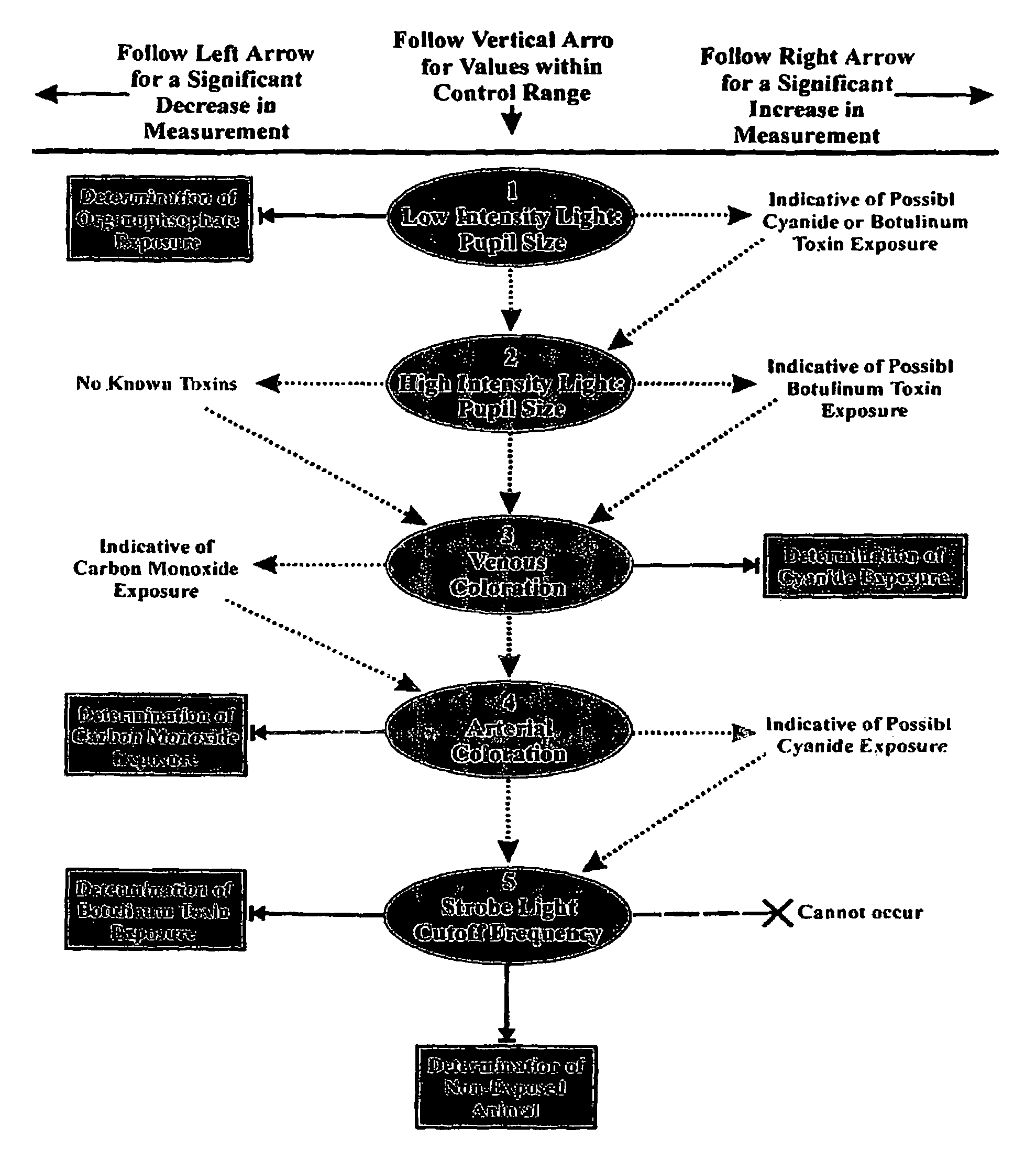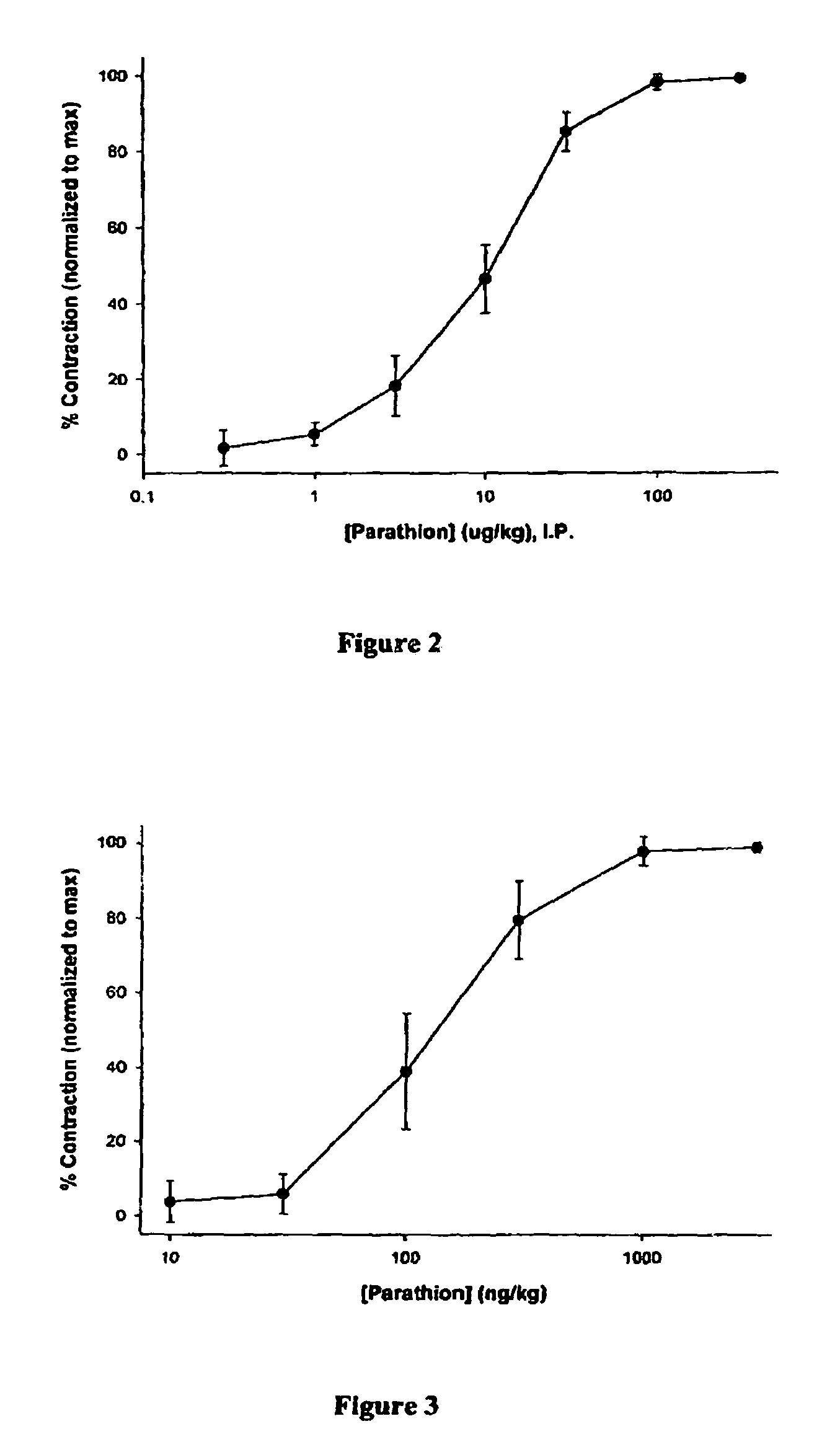Method for diagnosing a disease state using ocular characteristics
a disease state and ocular characteristic technology, applied in the field of ocular characteristics, can solve the problems of not providing a method for diagnosing any other disease state, such as exposure to chemical agents or biological toxins, and not providing a method for assessing the severity of exposure to such agents or toxins, so as to achieve rapid and accurate diagnosis of individuals
- Summary
- Abstract
- Description
- Claims
- Application Information
AI Technical Summary
Benefits of technology
Problems solved by technology
Method used
Image
Examples
example 1
Intraperitoneal Exposure to Organophosphates
[0056]Parathion is an organophosphate insecticide which has an identical mechanism of action to that of the organophosphate nerve agents (e.g., Soman, Sarin, VX, etc.) but has decreased potency compared to the warfare agents. Parathion was diluted in corn oil as necessary for dosing. The literature LD50 values (dose required to kill 50% of those animals exposed) were first validated for parathion. The literature value for rats exposed to intraperitoneal (I.P.) parathion is 2 mg / kg (i.e., 2 mg parathion per kg of rat body weight). The findings in the present study were consistent with this value—extrapolated LD50 value from concentration-response (death) curves was 2.47±0.67 mg / kg (± standard deviation). The lowest dose found to be lethal in any animal tested within 48 hours of administration (standard time length for LD50 testing) was 1.00 mg / kg. This occurred for only 1 of 5 animals tested at this dose.
[0057]Upon validation of the literat...
example 2
Direct Ocular Exposure to an Organophosphate
[0061]In addition to the intraperitoneal studies described above, groups of animals were also exposed to direct ocular parathion to better simulate likely warfare exposure (vapor exposure to the eyes and respiratory tract). These studies were conducted identically to those described above except that rather than I.P. injection, the left eye was exposed to 0.05 ml of the parathion concentration for a period of 3 minutes and then washed with saline. During the application period, animals were held under light (1%) halothane anesthesia to prevent unwanted movements or blinking which might alter the application time / integrity. Times post-exposure represent the amount of time elapsed from initial parathion application (i.e., parathion was washed off at 3 minutes post-exposure).
[0062]FIG. 3 shows the concentration-response curve for 5 minutes post-direct ocular exposure. The earlier time point was chosen for these studies as miosis developed muc...
example 3
[0063]The LD50 for potassium cyanide (KCN; Sigma-Aldrich, St. Louis, Mo.) was validated using subcutaneous KCN. The experimental LD50 value for subcutaneous KCN was 6.7±0.6 mg / kg compared to literature values ranging from 6 to 9 mg / kg. Studies were done with both anesthetized (with Ketamine / Xylazine, Sigma-Aldrich, St. Louis, Mo.) and unanesthetized animals. No differential effects were observed. Animals that survived the first two hours after KCN exposure, survived for the duration of the two day (48 hour) observation, demonstrating the highly acute effects of cyanide overexposure.
[0064]For completion of the studies, a rat model (Sprague-Dawley) of subcutaneous (S.C.) exposure to KCN was employed. For all experiments, KCN was dissolved in normal saline such that a volume between 0.2 and 1.0 ml would be injected. As with the parathion experiments, post-injection data was compared to control data obtained prior to injection of KCN for each animal. In addition, a gr...
PUM
 Login to View More
Login to View More Abstract
Description
Claims
Application Information
 Login to View More
Login to View More - R&D
- Intellectual Property
- Life Sciences
- Materials
- Tech Scout
- Unparalleled Data Quality
- Higher Quality Content
- 60% Fewer Hallucinations
Browse by: Latest US Patents, China's latest patents, Technical Efficacy Thesaurus, Application Domain, Technology Topic, Popular Technical Reports.
© 2025 PatSnap. All rights reserved.Legal|Privacy policy|Modern Slavery Act Transparency Statement|Sitemap|About US| Contact US: help@patsnap.com



